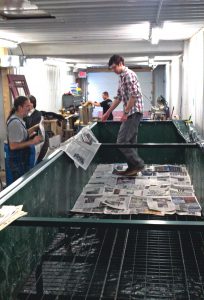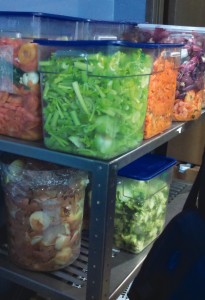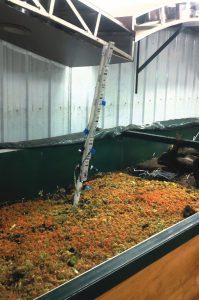After 16 months of operation, a University of Wisconsin-La Crosse program has diverted over 7 tons of food waste and produced several thousand pounds of worm castings.
Ryan Perroy and Leah Schiller
BioCycle April 2012, Vol. 53, No. 4, p. 29

Joseph Kotnour, a University of Wisconsin-La Crosse student, prepares the vermicomposting bin for the initial shipment of worms by laying down a thin layer of newspaper over the mesh bottom.
Prior to the current program, a number of earlier student-led composting projects operated at various times on the semiurban UW-L campus. Hampered by a lack of on-campus space, insufficient training of composting volunteers, and concerns about rodents and odors by UW-L Facilities staff, these programs tended to wax and wane with the involvement and graduation of motivated students. The last incarnation, which lasted from 2008-2010 and included both pre and postconsumer waste, was extremely successful in collecting large quantities of food waste but failed in terms of management of the collected materials.
It was on the heels of this uneven performance (high student interest and compliance but poor execution) that the vermicomposting program was conceived. Given space limitations on campus, the original plan was to partner with a local nonprofit greenhouse and senior educational center located five blocks away, which would provide a climate-controlled site for the facility in return for a portion of the produced castings. Based on this arrangement, a grant proposal to purchase a 5-foot by 32-foot industrial continuous-flow reactor and 100 lbs of red wiggler worms was submitted to the UW-L ‘Green Fund,’ a student fee-driven fund dedicated to supporting sustainable initiatives on campus. The grant proposal was successful and a vermicomposting unit was ordered from Sustainable Agricultural Technologies, Inc.
Shortly after placing the order, UW-L learned that its partner greenhouse was unexpectedly declaring bankruptcy and could not support the program. Alternative sites to house the facility were proposed, inspected and discarded for a variety of logistical reasons including distance from campus, lack of climate control and accessibility issues. Finally, space in a former meat-packing plant on the north side of La Crosse was donated by a local businessman with an interest in vermicomposting. In addition, he covered renovation costs associated with installing an adequate heating and ventilation system, purchased additional insurance, and met other permitting requirements imposed by the City of La Crosse. Without these acts of generosity, the program would never have materialized.
A newly created local nonprofit, Hillview Urban Agriculture Center (HUAC), also stepped forward to assist in logistics and operational management of the vermicomposting unit, in return for ownership of the castings to support their mission of promoting local food and sustainability programs. An agreement with UW-L was reached and the vermicomposting unit was delivered in early January 2011. One hundred pounds of red wiggler (E. fetida) worms were purchased from Uncle Jim’s Worm Farm in Pennsylvania, as local Wisconsin suppliers were unable to access their hibernating worm stocks in the coldest part of the winter. Preconsumer food scraps collection began in January 2011, and postconsumer collection was added in November 2011.
Organization, Operations and Troubleshooting
The day-to-day logistics of collecting and delivering food waste and maintaining the system have fallen to two main partners: UW-L and HUAC. During the academic year, UW-L provides compostable feedstock and a handful of staff and student volunteers to assist with logistics. These include maintaining food waste shredding equipment, raising student awareness about food waste sorting through signage and volunteers stationed at the food tray return center, and occasionally delivering collected materials to the off-campus vermicomposting system. Contracted on-campus food services staff (Chartwells) sort and collect preconsumer vegetable and fruit (excluding citrus) waste, and transport all collected materials to the kitchen loading dock for pick-up; their participation and cooperation has been vital. UW-L faculty and students are also involved in vermicomposting efficiency research projects and community outreach and educational events, including field trips to the facility, poster sessions and public talks. HUAC provides funding to cover monthly utility costs and a part-time ‘worm husband’ who is responsible for maintaining the bin and food material logistics. Due to seasonal variations in the amount of food waste produced on campus, a number of other organizations (including the local People’s Food Co-op) provide supplemental food waste and paper materials as needed.

Pre and postconsumer food waste is processed in a small shredder before transport to the composting site.
Early in the project there were problems related to overfeeding, a common issue for first-time operators. Originally, collected food materials were not processed to reduce their particle size before being added to the bin. Large pieces and even whole fruits and vegetables were commonly added. By including these large pieces and overfeeding in general, near-thermophilic composting conditions were created that were readily picked up by the installed sensors. In addition to creating pulses of extremely elevated temperatures (>100°F) within the bin that lasted for days or weeks, the in-situ decomposition of added food materials also produced odors and attracted fruit flies. This situation became problematic for the other operations housed in the warehouse — including a catering company, machine shop and business office space — and disruptive for the UW-L kitchen staff who were instructed to stop and start food waste collection based on environmental conditions within the bin.
In the following weeks and months, modifications to the program were made to deal with these issues. HUAC purchased an additional 50 lbs of worms to increase the amount of food waste processed on a weekly basis and UW-L, again via a successful grant proposal to the Green Fund, was able to purchase and install the chipper/shredder in August 2011 to reduce particle size. These changes, along with the increased expertise of the ‘worm husband,’ have had a dramatic impact on the efficiency of the program and quality of produced castings.
Lessons Learned

Shredded food waste is applied to the top section of the vermicomposting bin. A vertical temperature and humidity sensor tower array (center of photo) helps monitor the process.
As in any project involving multiple partners, adequately balancing varying needs and goals can be a challenge. The UW-L program requires cooperation of kitchen staff, managers, administration, student volunteers, partner organizations and occupants of the warehouse where the facility is housed. Maintaining open lines of communication, regularly updating these different groups about developments and problems as they occur, and minimizing disruption to all parties are all critical to success. It is also valuable to periodically step back from the daily operational demands and minor complications to refocus on the larger picture and goals.
To date, over seven tons of pre and postconsumer food waste materials have been diverted out of the UW-L solid waste stream. An initial harvest of the vermicomposting system in November 2011 produced about 2,000 lbs (moist weight) of finished worm castings. A second harvest scheduled for late April is anticipated to yield an additional 2,000 lbs or more. Castings are sold or donated for use in local gardens and agricultural fields to grow food and flowers without the use of industrial fertilizers. A pilot program to apply worm castings to the UW-L campus grounds is also in preparation. The program also serves an important and growing educational role: in addition to those immediately involved in studying the vermiculture experiment, hundreds of students and citizens have toured the facility or otherwise learned about the program at different events. The hope is to create a program that is adaptable for other interested schools and institutions.
Ryan Perroy is an Assistant Professor in the Department of Geography & Earth Science at the University of Wisconsin-La Crosse and Director of the UW-L Vermicomposting program (rperroy@uwlax.edu). Leah Schiller is a UW-L undergraduate student and research assistant. They both dig worms.










